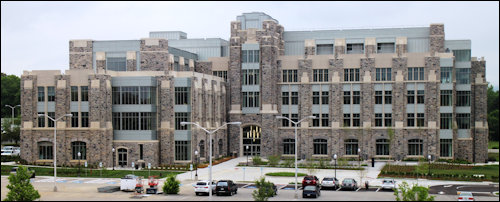
Virginia Tech’s Goodwin Hall: traditional hokie stone on the outside, braniac smart building on the inside
by James A. Bacon
Virginia Tech has been re-thinking for a several years now how to invigorate traditional engineering disciplines by integrating civil engineering and computer engineering to create “smart infrastructure.” The $100 million initiative received a $5 million boost yesterday from the Hitt family, owners of Falls Church-based Hitt Contraction, a company that typically recruits eight to ten Virginia Tech graduates every year, according to the Washington Business Journal.
The Tech initiative is incredibly timely. In arguably the biggest revolution since the invention of structural steel that made possible the construction of new classes of bridges and skyscrapers in the 1930s, the so-called Internet of Things (IoT) is introducing radical change to the construction industry. The IoT is a catch phrase for the integration of ubiquitous sensors into buildings and structures that generate data that can be used to improve performance.
An in-house Virginia Tech article made note last year of Virginia Tech’s “Smart Infrastructure Laboratory,” which includes smart building technology that, among other things, can guide occupants to safety during disasters, and its Structural Systems and Lifecycle Reliability Team, which works at the intersection of engineering materials and systems to advance structural safety, resiliency and durability.
Virginia Tech’s Goodwin Hall … is known as the world’s most-instrumented building for measurement of vibrations. Measuring motion and vibration inside and outside the walls, 212 accelerometers can detect even the slightest movement. The sensors feed data into data acquisition boxes via 65,000 feet of cable interconnecting the entire system. Data can be used to save energy costs, guide maintenance crews, or deploy first responders in an emergency.
The Structural Systems and Lifecycle Reliability Team has a measurement and visualization system that can generate 3-D representations of any object or environment over time. These models can identify gradual changes such as a gusset plate buckling in a bridge or cracks in a building after an earthquake. The system has been used to measure deformations in a steel plate wall and in the field to identify cracks in a concrete bridge over the James River.
Virginia Tech will start work in January on “Hitt Hall” for smart construction and another unnamed building for intelligent design. Meanwhile, Tech is expanding and linking its smart road partnership with the Virginia Department of Transportation (VDOT), its smart city partnership with Arlington County, and a 300-acre “smart neighborhood” to serve as a proving ground for new technologies.
Bacon’s bottom line: The Internet of Things is revolutionizing the built environment — everything from buildings to roads and bridges, from waste water systems to electric grids. The cost of sensors is plummeting, and so is the cost of transmitting data to the Cloud. The idea of “smart” bridges and “smart” buildings is not hype — it’s real. It’s here. And leading construction companies like Hitt are building teams that can pull all the pieces together. Tech is wisely making the program multidisciplinary, opening it up to engineers, business majors and students in other study areas, reports the WBJ, “as the lines between technology, infrastructure and business continue to blur.”
I can’t believe that Virginia Tech is the only university exploiting this opportunity — I don’t track what other institutions are doing — but at the very least it deserves kudos for being an early mover. Hopefully, Virginia-based companies like Hitt Construction will tap graduates with the new skill sets to gain a competitive economic advantage in the marketplace.
Meanwhile, Virginia political and government leaders would do well to acquaint themselves with the state-of-the-art work at Virginia Tech and start thinking creatively how to apply the Internet of Things to Virginia’s own infrastructure. The potential maintenance savings from the application of smart technologies to government-owned buildings, utilities and transportation infrastructure is immense. The potential to optimize transportation systems, conserve energy and reduce man’s impact on the environment is transformative. VDOT and Arlington County are ahead of the curve. Everyone else needs to get with the program.


